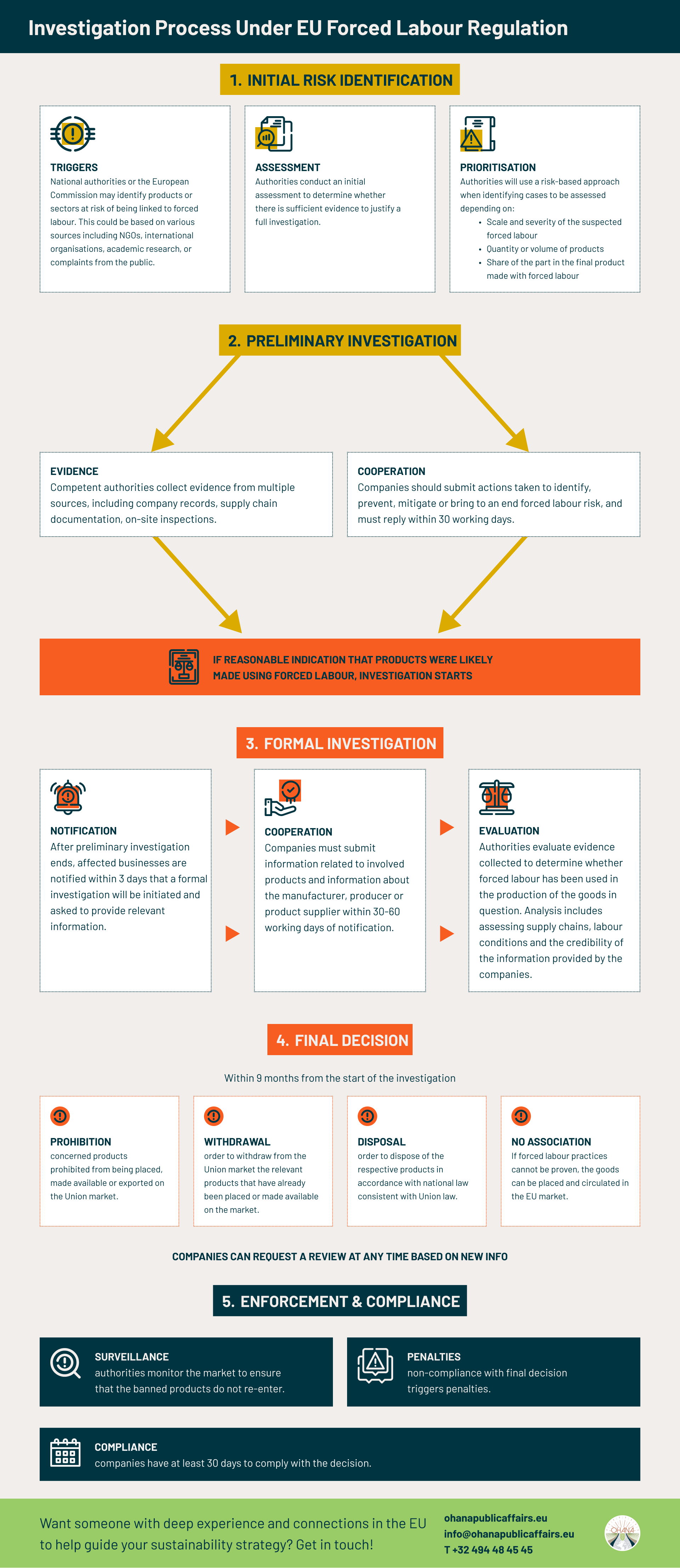In addition to its extensive environmental agenda, the European Union is taking a bold stand against human rights violations, banning products made with forced labour from the Single Market through its new EU Forced Labour Regulation.
As we await the European Parliament’s final green-light for the regulation’s text, expected in November 2024, now is the perfect time for us to dive in and explore the details of this important legislation. Since the new law applies to organisations of any size and sector, the insights and recommendations included in this piece will be a great asset in readying your business for this critical milestone in EU policy.
Want someone with deep experience and connections in the EU to help guide your sustainability strategy? Get in touch!
What is The EU Forced Labour Regulation and Why it Matters
The EU Proposal for a Ban on Products Made with Forced Labour is part of the bloc’s broader commitment to upholding human rights and guaranteeing that goods placed in the Single Market have not been tainted by forced labour. This is a highly relevant piece of legislation, not only because it addresses grave human rights violations, but also because it places new responsibilities on businesses in order to eradicate this practice. Ultimately, companies commercialising products within the EU will have to ensure that their global supply chains are forced labour free, or face severe penalties.
The Scale of The Problem
The Regulation targets a global issue which has proven difficult to combat, with an estimated 28 million people currently trapped in forced labour worldwide, according to the International Labour Organization (ILO). Alarmingly, this figure represents a growth from the 25 million occurrences registered in 2016.
Despite popular belief, the forced labour issue is not exclusive to low-income countries — 52% of the cases occur in upper-middle-income or high-income nations. The Asia-Pacific region accounts for 55% of the total number of cases, although 880,000 instances of this type of violation have been found within the EU itself. Women and girls constitute 40% of those affected worldwide, with migrants facing a risk three times higher of being subjected to forced labour.
Understanding Forced Labour
Up until now, the international community looked to address the forced labour issue through various legal instruments, including:
- ILO Convention No. 29 on forced labour;
- Article 5 of the Charter of Fundamental Rights of the European Union, which prohibits slavery, servitude, forced or compulsory labour, and human trafficking.
- Article 4 of the European Convention on Human Rights, which states that no one should be required to perform forced or compulsory labour.
- UN Guiding Principles on Business and Human Rights (UNGP)
- OECD Guidelines on due diligence and responsible business conduct (RBC).
However, there was no specific EU legislation targeting the matter of products of forced labour. The new regulation is the first to empower Member State authorities to directly intervene by detaining, seizing, or withdrawing products identified as being made with forced labour.
Identifying Forced Labour
Step one in the process of eradicating any issue is being able to spot it. Forced labour can be found throughout the supply chain.
As defined by the ILO Convention No. 29, forced labour is “all work or service which is exacted from any person under the threat of a penalty and for which the person has not offered himself or herself voluntarily.”
Although the European Commission will release its own specific guidelines on how to identify a case of forced labour, the ILO outlines a number of indicators that represent the most common signs of a possible forced labour violation, including:
- Abuse of vulnerability
- Deception
- Restriction of movement
- Isolation
- Physical and sexual violence
- Intimidation and threats
- Retention of identity documents
- Withholding of wages
- Debt bondage
- Abusive working and living conditions
- Excessive overtime
In some instances, a single indicator may already imply the presence of forced labour. However, the ILO indicators alone may not be sufficient to detect state-imposed forced labour, for example, which stands as a key focus of the new EU Forced Labour Regulation.
Key Aspects of The New Policy
The EU Forced Labour Regulation covers a number of critical aspects that businesses must be aware of to ensure compliance.
Scope
The regulation applies to all goods, at every stage of their supply chain, whether produced within the Union or imported, and to both EU and non-EU businesses of all sizes. Products made with forced labour may not be placed or exported from the EU market, and companies found in violation will face severe penalties, including product seizures, withdrawal from the market, and fines.
Due Diligence
Although the regulation does not establish a mandatory due diligence process, compliance will require businesses to conduct thorough supply chain checks, including with the purpose to provide evidence in case of an investigation. The text makes reference to related Union-wide and local regulations, such as the Corporate Sustainability Due Diligence Directive (CSDDD), while avoiding imposing additional due diligence requirements beyond existing obligations, particularly for SMEs, which are not covered under the CSDDD.
The Investigation Process
When suspicions of forced labour arise, the new regulation establishes that a thorough investigation process must be followed, according to the steps illustrated below. As detailed in our previous update on the EU Forced Labour Regulation, investigations beyond the EU’s borders will be conducted by the European Commission, while suspected violations within Member States will be handled by the states’ National Competent Authorities (NCAs).

Support Measures for Impacted Organisations
To facilitate compliance with this new set of rules, the EU will publish specific guidelines within 18 months of the legislation’s entry into force, before mid-2026. These guidelines will help economic operators and national authorities identify, prevent, and address forced labour risks, with a particular focus on high-risk countries and sectors.
Additionally, the EU is establishing the Forced Labour Single Portal, a resource hub containing guidelines, information on prohibitions, a database of high-risk areas, and a whistleblower system. Special measures will also be made available for SMEs to ensure that they are not disproportionately impacted by the new regulations.
How to Prepare Your Business for What’s Coming: Our Recommendations
As usual, proactivity will be the key to success in guaranteeing that your company will be up to standard when the new rules start applying. Here are some strategic recommendations to put you ahead of the curve:
- Conduct Thorough Due Diligence: While due diligence is not mandatory under the new regulation, it’s essential for spotting and addressing adverse impacts such as forced labour and an instrument for demonstrating compliance. Companies should map their supply chains, pinpoint high-risk areas, and implement effective risk management strategies.
- Ensure Full Supply Chain Traceability: Establishing an effective traceability system will be crucial, particularly for the suppliers in high-risk regions and high-risk parts of the supply chain. Develop a step-wise approach to increase transparency and traceability in your supply chains.
- Engage with Suppliers: Collaboration with suppliers is essential to ensuring that your entire supply chain is compliant. Get in touch with your partners to start assessing the situation and planning the next steps. This may involve assisting suppliers in implementing mitigating measures and ensuring contracts include clauses prohibiting forced labour.
- Collaborate with Stakeholders: Addressing an issue of this scale will undoubtedly require collective action. Reach out and collaborate with industry peers and other relevant entities working to eradicate forced labour, particularly those with a presence on the ground in high-risk areas.
- Prepare for Responsible Disengagement: If mitigating forced labour risks proves unfeasible, responsibly exiting affected supply chains may be necessary. In these cases, ensure that your disengagement is handled ethically and transparently with the least possible adverse impacts on people. This will help safeguard your company’s reputation.
By banning products made with forced labour, the EU clearly sets a new global standard for ethical business practices and human rights protection. Although the details about how enforcement will be conducted are still to be released, businesses should waste no time in developing a strategy to ensure violation free operations.
At Ohana, we have a team of experts ready to guide your organisation towards compliance, boosting your business competitiveness, while also contributing to a fairer and more transparent global market.
So get in touch with us, and let’s get started!


